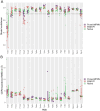Exploring the potential of structure-based deep learning approaches for T cell receptor design
- PMID: 39348412
- PMCID: PMC11466415
- DOI: 10.1371/journal.pcbi.1012489
Exploring the potential of structure-based deep learning approaches for T cell receptor design
Abstract
Deep learning methods, trained on the increasing set of available protein 3D structures and sequences, have substantially impacted the protein modeling and design field. These advancements have facilitated the creation of novel proteins, or the optimization of existing ones designed for specific functions, such as binding a target protein. Despite the demonstrated potential of such approaches in designing general protein binders, their application in designing immunotherapeutics remains relatively underexplored. A relevant application is the design of T cell receptors (TCRs). Given the crucial role of T cells in mediating immune responses, redirecting these cells to tumor or infected target cells through the engineering of TCRs has shown promising results in treating diseases, especially cancer. However, the computational design of TCR interactions presents challenges for current physics-based methods, particularly due to the unique natural characteristics of these interfaces, such as low affinity and cross-reactivity. For this reason, in this study, we explored the potential of two structure-based deep learning protein design methods, ProteinMPNN and ESM-IF1, in designing fixed-backbone TCRs for binding target antigenic peptides presented by the MHC through different design scenarios. To evaluate TCR designs, we employed a comprehensive set of sequence- and structure-based metrics, highlighting the benefits of these methods in comparison to classical physics-based design methods and identifying deficiencies for improvement.
Copyright: © 2024 Ribeiro-Filho et al. This is an open access article distributed under the terms of the Creative Commons Attribution License, which permits unrestricted use, distribution, and reproduction in any medium, provided the original author and source are credited.
Conflict of interest statement
The authors have declared that no competing interests exist.
Figures







Update of
-
Exploring the Potential of Structure-Based Deep Learning Approaches for T cell Receptor Design.bioRxiv [Preprint]. 2024 Apr 24:2024.04.19.590222. doi: 10.1101/2024.04.19.590222. bioRxiv. 2024. Update in: PLoS Comput Biol. 2024 Sep 30;20(9):e1012489. doi: 10.1371/journal.pcbi.1012489. PMID: 38712216 Free PMC article. Updated. Preprint.
Similar articles
-
Exploring the Potential of Structure-Based Deep Learning Approaches for T cell Receptor Design.bioRxiv [Preprint]. 2024 Apr 24:2024.04.19.590222. doi: 10.1101/2024.04.19.590222. bioRxiv. 2024. Update in: PLoS Comput Biol. 2024 Sep 30;20(9):e1012489. doi: 10.1371/journal.pcbi.1012489. PMID: 38712216 Free PMC article. Updated. Preprint.
-
A generalized framework for computational design and mutational scanning of T-cell receptor binding interfaces.Protein Eng Des Sel. 2016 Dec;29(12):595-606. doi: 10.1093/protein/gzw050. Epub 2016 Sep 13. Protein Eng Des Sel. 2016. PMID: 27624308 Free PMC article.
-
TPepRet: a deep learning model for characterizing T-cell receptors-antigen binding patterns.Bioinformatics. 2024 Dec 26;41(1):btaf022. doi: 10.1093/bioinformatics/btaf022. Bioinformatics. 2024. PMID: 39880376 Free PMC article.
-
Engineering the T cell receptor for fun and profit: Uncovering complex biology, interrogating the immune system, and targeting disease.Curr Opin Struct Biol. 2022 Jun;74:102358. doi: 10.1016/j.sbi.2022.102358. Epub 2022 Mar 25. Curr Opin Struct Biol. 2022. PMID: 35344834 Free PMC article. Review.
-
Structural and dynamic control of T-cell receptor specificity, cross-reactivity, and binding mechanism.Immunol Rev. 2012 Nov;250(1):10-31. doi: 10.1111/j.1600-065X.2012.01165.x. Immunol Rev. 2012. PMID: 23046120 Review.
Cited by
-
Origins of T-cell-mediated autoimmunity in acquired aplastic anaemia.Br J Haematol. 2025 Apr;206(4):1035-1053. doi: 10.1111/bjh.19993. Epub 2025 Jan 21. Br J Haematol. 2025. PMID: 39836983 Free PMC article. Review.
References
MeSH terms
Substances
Grants and funding
LinkOut - more resources
Full Text Sources
Research Materials

